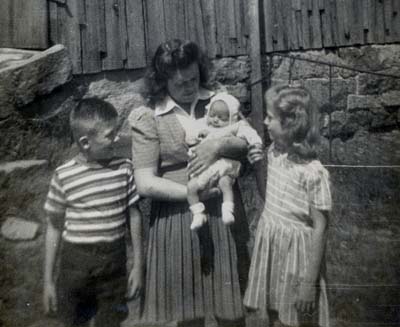Bunner Ridge: Life beyond the Paved Road
By William Kent Hudgins

The Mt. Nebo School was the last one-room schoolhouse in Marion County when it closed in 1972. Photo by William Kent Hudgins.
As I look back on my childhood, one year, in particular, brings back fond memories. It was the short period my family lived on Bunner Ridge in Marion County. This hilly 177-acre farm was about 10 miles from the Fairmont city limits, just beyond the paved road and modern conveniences. The thoughts presented here are a combination of my personal recollections and oral histories of family members.
My story begins with my father, William Ellsworth Hudgins, who entered the service of our country during World War II while working at the Fairmont post office. After completing basic training at Great Lakes Naval Training Center near Chicago, he served at the Fleet Post Office in San Francisco. During this time, my parents received a letter from my great-aunt Stella Summers, asking if they would move to and help out with her farm on Bunner Ridge after Dad was discharged. My parents accepted—in part because they knew good housing would be hard to find after the war.
My father lacked much knowledge or skills about farm work. While still in the Navy, though, he enrolled in off-duty agricultural training, with focuses on poultry, livestock, and land conservation. The period between summer 1946 and fall 1947 was challenging for my father. He had to apply the principles he’d learned vicariously through his training and readings. It was also about this time that my first memories began to blossom.
Dad was born and raised in Fairmont and was employed full-time as a mailman. He adapted to farm life with guidance from Aunt Stella and other family members. He harnessed a pair of Belgian horses, Queen and Dory, to plow and seed the fields; many times, I rode on the horses’ backs while holding the hames. In addition, he milked the cows, fed the hogs, tended the livestock, and made certain that all structures and equipment were in good condition. In summer and fall 1946, he harvested the crops, stacked the hay, dressed the pigs, and performed all the necessary chores in preparation for winter.
My mother, Kathryn Agatha Freeman Hudgins, didn’t adjust as well to the rural way of living. The domestic amenities she’d enjoyed, expected, and deserved during her young married life were not available on Bunner Ridge. Making things even more challenging, my sister Kathryn Ann was born in July 1946.
Our house was heated in the winter by a wood stove, which also served as our cook stove, except for when we used the three-burner kerosene stove on the back porch. Water was supplied by a pitcher pump near the sink. I remember taking bathes in tubs near the stove. For refrigeration, we placed our milk, butter, vegetables, and most other food in a springhouse a few feet from the kitchen door.
As was common in those days, no indoor facilities were available. There was a privy on the hill behind the house. Inside the house, in a very conspicuous location, there was an ornate lidded jar for nighttime usage. The task of emptying the slop jar fell to the adults—a policy never contested by younger family members.
If I remember correctly, Aunt Stella’s bedroom was off the living room. All other bedrooms were upstairs and accessible only by a narrow stairway. These rooms were unheated except for a small floor register that permitted the warmth from the kitchen stove to ascend and keep the frost from forming. In winter, we wrapped our entire bodies, including our heads, in heavy comforters and knotted quilts.
You can read the rest of this article in this issue of Goldenseal, available in bookstores, libraries or direct from Goldenseal.